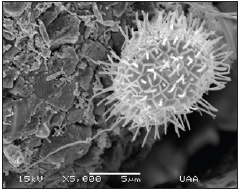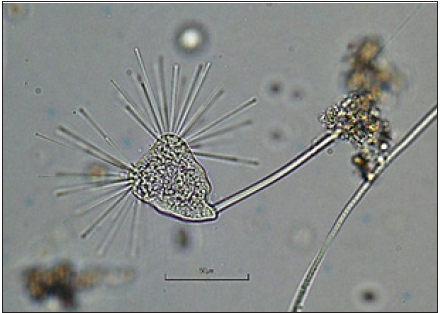- Submissions

Full Text
Biodiversity Online J
Some Freshwater Suctorians from Aguascalientes State, Mexico
Marcelo Silva-Briano*, Araceli Adabache-Ortiz, Ana Ekaterina Retes-Pruneda and Rocío Natalia Armas-Chávez
Autonomous University of Aguascalientes, Basic Sciences Center, Ecology Av University, Mexico
*Corresponding author: Marcelo Silva Briano, Autonomous University of Aguascalientes, Basic Sciences Center, Ecology Av University, Mexico
Submission: February 19, 2021; Published: March 23, 2021

ISSN 2637-7082Volume1 Issue3
Abstract
Suctories are ciliated protists that trap their prey through long tentacles that have haptocysts at the tip and suck up the cell’s contents. Some representatives have been found in the freshwater bodies of the state of Aguascalientes, Mexico. So, it is important to know the biodiversity of this group.
Keywords: Ciliophora; Suctoria; Preys; Waterbodies; México
Introduction
The suctories (Ciliophora: Suctoria), are the vampires of the waterbodies, due not having a cytostome to feed, instead they have long capitate suction tubes or not called haptocysts (Figure 1-4), and with or without basal widening [1], similar to tentacles, which when catching their prey, they suck the contents of the cell until they are practically empty. They are relatively common in the state of Aguascalientes, which contains myriads of small temporary ponds and some dams that provide drinking water to cities and to water livestock in rural communities.
Figure 1: Suctorian (unidentificated), showing the no capitate haptocysts, with the basal widening, attached to surface of the tecate Sarcodina Difflugia sp. Dam Arroyo Seco. Ags. México. SEM imagen. M: 172. Coordinates: 21° 57’ 46.26” N; 102° 23’ 21.18”.

Figure 2:Probably Discophrya sp., suctorian showing the capitate haptocysts, apparently without basal widenings close to mass of organic matter. Also, shows the large vacuoles in the cytoplasm. Pond UAA, Ags. Digital imagen. Coordinates: 102° 18’ 57.42’’.

Figure 3: Tokophrya sp. suctorian ciliate that lives as a predator using its capitate straight haptocysts that it uses to penetrate the prey by sucking the victim’s cellular content, since they do not have a cytostoma (mouth). Inhabits small ponds. Collected in Pond UAA, Ags. Digital imagen.

Figure 4:Tokophrya sp. suctorian living on a rotifer (Filinia cornuta), probably uses it as a transport (Foresia), the basal widening is attached to the rotifer and is showing its tentacles that at the tip of these contain haptocysts, which suck the content of the prey. Pond UAA, Ags. Digital imagen.

Objectives
The aim of this work to show with SEM and digital images the presence of these ciliated protists in the waterbodies in Aguascalientes State.
Materials and Methods
Plankton samples were taken in different localities of the state, these were fixed in 4% formaldehyde, prepared for SEM (JEOL LV- 5900), and digital images were obtained from living organisms, using a NIKON Eclipse light microscope, and a Ni digital camera.
Results
The results are the following. The Suctorians found in the study are: Unidentificated (Figure 1), Discophrya cf. elongata (Figure 2), [2], and Tokophrya sp (Figure 3 & 4), [3].
Conclusion
The presence of these ciliates contribute to the balance of freshwater ecosystems. It is necessary to do more studies of this group, to know the biodiversity, understand the function of these ecosystems and their importance.
References
- Kuppers GC (2020) Thorp and Covich’s freshwater invertebrates. (4th edn), Elsevier, Academic Press, Pp. 1017.
- Júnio Pedroso D, D`Ávila S, D`Agosto M (2006) First Record of epibionts peritrichids and suctorians (protozoa, ciliophora) on pomacea lineata (spix, 1827). Brazilian Archives of Biology and Technology 49(5): 807-812.
- Mariño-Pérez R, Mayén-Estrada R, Macip-Ríos R, Dovgal I (2011) Morphometric variations of Discophrya elongata (Ciliophora, Suctorea) attached to two different species of aquatic true bugs (Hemiptera, Prosorrhyncha, Nepomorpha). Vestnik zoologii 45(5): e13-e19.
© 2021 Marcelo Silva-Briano. This is an open access article distributed under the terms of the Creative Commons Attribution License , which permits unrestricted use, distribution, and build upon your work non-commercially.
 a Creative Commons Attribution 4.0 International License. Based on a work at www.crimsonpublishers.com.
Best viewed in
a Creative Commons Attribution 4.0 International License. Based on a work at www.crimsonpublishers.com.
Best viewed in 







.jpg)






























 Editorial Board Registrations
Editorial Board Registrations Submit your Article
Submit your Article Refer a Friend
Refer a Friend Advertise With Us
Advertise With Us
.jpg)






.jpg)














.bmp)
.jpg)
.png)
.jpg)










.jpg)






.png)

.png)



.png)






